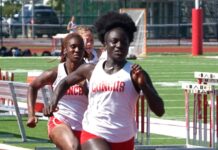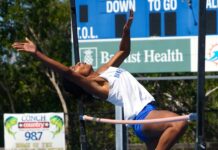
Several months ago, I was asked to speak to the Sunrise Rotary Club about people I’ve met in my 65 years as a sports journalist. As I thought about it, I realized I’ve met a lot of noteworthy people, but not necessarily for news stories or even sports personalities.
This column is a result of that speech. If you’re a member of Sunrise Rotary, much, but not all of this, may sound familiar. I’ve divided my speech into two columns, to run this week and next.
To start, I ran into Key West legend Boog Powell at a Key West High School baseball gathering a few months ago at Rex Weech Field. I was amazed he remembered me.
In the early 1960s, I was writing for the Rochester, New York Times-Union and Boog was playing for the Rochester Red Wings. I covered the last game of the season and did not mention him.
“I led the (International) league in batting and all you could write about was Jimmy Finnigan getting the hit that won the game. I was really upset,” recalled Boog. But we sat and talked for a long time at the Rex. It was great. And I wrote a column about it.
Back in 1958, I was walking down Sandusky Street in Delaware, Ohio, when I spotted an elderly gentleman at a crosswalk who obviously needed some help. I took him by the arm and assisted him across the street. It turned out we were headed to the same lunch event at Ohio Wesleyan University. He was a member of the board of trustees. I was invited as a student. We sat together and chatted.
He was Branch Rickey and he talked to me about integrating Major League baseball in 1947 by signing Jackie Robinson to the Brooklyn Dodgers when Rickey was president and general manager of the team. How often I’ve wished I’d had pen and paper to take down all he told me.
Rickey, who was a catcher in the Major Leagues while he was a student and coach at Ohio Wesleyan, died Dec. 9, 1965, just short of 84. I wrote a lengthy obituary for the Dayton Daily News, where I was employed for 29 years, 3 months. ESPN named Rickey the most influential sports figure of the 20th century.
When I graduated from Ohio Wesleyan, I got a sports writing job at the Rochester Times-Union, thanks to Professor Verne Edwards Jr. Rochester had just lost its pro basketball team, the Royals, to Cincinnati and as I loved basketball, I covered some games that were still being played in Rochester as well as some in Syracuse, which had a team called the Nationals.
While covering auto racing at Watkins Glen, I interviewed the great Sterling Moss, among others.
I interviewed Jimmy Clark, who later won the Indianapolis 500. He and I talked in his trailer for a while before he apologized, telling me the BBC was on hold, waiting to interview him. It wasn’t long after that he was killed in a race.
Driver Graham Hill met the same fate, but in an airplane. I interviewed him after he won the U.S. Grand Prix at Watkins Glen and before he won at Indianapolis.
I met boxer Ingemar Johannson, who had knocked out Floyd Patterson and would be knocked out twice by Patterson in three world heavyweight championship fights. Fresh out of college, and shortly after I started work in Rochester, I covered a fight involving Nino Valdes, one of Cuba’s best fighters, as he defeated Mike DeJohn by split decision.
Through Jack Twyman I came to know of Maurice Stokes, who had been a star with the Rochester Royals and had developed an illness that paralyzed him. With pen in mouth, Stokes had written some commentary about life, a copy of which I obtained from Twyman, who had become Stokes’ caretaker. I had promised Twyman I would not use the commentary until Stokes’ death. The day after Stokes died, I wrote an article for the Dayton Daily News that was judged nationally as the best basketball column of that year.
I have met four presidents.
Jimmy Carter was coming out of a meeting with editorial types and our paths crossed at the Daily News. We chatted for a while as then-Gov. Carter campaigned for the presidency. I shook, or at least touched the hand of, President Lyndon B. Johnson, as he concluded a speech in Dayton. Gerald Ford was vice president when we stood next to each other in a buffet line at an outdoor dinner party in Dayton. One time, when I was a newspaper magazine editor in Dayton, I was on the telephone with Vice President George Bush, who had played baseball at Yale. All four became president.
When I was a summer intern at the Jeffersonian in Cambridge, Ohio, I went to nearby New Concord to interview Cambridge native, then-Major John Glenn, who had just set a jet coast-to-coast speed record. He and his family had arrived early in the morning for a visit with his parents and a celebration of his new record. “Come on, help me unload my car while we talk,” he offered. We talked the rest of the morning. I took pictures of Glenn, his wife and children. I wonder what happened to the prints. I know what happened to him. John Glenn became an astronaut, a four-term U.S senator, a candidate for U.S president and, at 77, took his second trip into space.
I have interviewed several Cincinnati Reds players, including Johnny Bench, with whom I lunched, and, of course, Pete Rose. When I was executive sports editor in Dayton, my staff led the reporting on Rose’s crimes that led to him being banned from the sport and imprisoned for tax evasion. Our coverage was a finalist for the Pulitzer Prize. During that time, a friend asked me, “What are you doing to Pete Rose? I like him a lot.” I told her, “I like him a lot, too.”
I’ll continue my list of memorable meetings in next week’s column. In the meantime, Happy Thanksgiving.



















